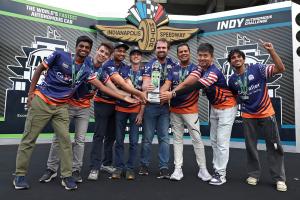
The University of Virginia won the speed trial portion of the Indy Autonomous Challenge at the Indianapolis Motor Speedway on Friday with the top speed of 171 mph, making an American team the fastest for the first time in the challenge’s four-year history.
An exciting livestream documented the victory for UVA’s robot racecar team, Cavalier Autonomous Racing — also known as “CAR” or “CAVCAR” for short.
"This is a big win for us," said doctoral student Trent Weiss, a UVA School of Engineering and Applied Science computer science student specializing in AI perception, just after the finish.
The decisive lap happened following a rain delay that required the track to be dried by air blowers.
The robot and the coding is driving absolutely beautiful lines.
"The robot and the coding is driving absolutely beautiful lines," Greg Creamer, a celebrated racing play-by-play announcer and pit reporter, stated, before exclaiming, "171.011!"
UVA Engineering associate professor Madhur Behl, the team principal, noted that the team’s fastest speed was derived as an average speed for that lap. Unofficially for the contest, but on the record, the car was traveling at 184 mph when it last crossed the "Yard of Bricks" portion of the track.
In fact, the team achieved a record lap time of 52.62 seconds.
"This speed is the fastest the Indy Autonomous Challenge has ever seen in any race," Behl said.
This speed is the fastest the Indy Autonomous Challenge has ever seen in any race.

Behl, who teaches both computer science and systems information engineering, also noted on social media after the race, "This [speed accomplishment] was our goal from the start and therefore, despite less-than-ideal track conditions and colder weather, we knew we had the pace — and fully sent it."
The Indy Autonomous Challenge is a collection of universities competing in unmanned Dallara racecars, built like actual one-seater F1 racecars but with high-tech computing equipment in the cockpits. The goal of the challenge is to advance autonomous vehicle safety by amping up the variables autonomous vehicle might face on the roads.
Creamer, the professional announcer, at times had trouble containing his excitement for what AI-controlled machines, and in particular CAVCAR, could do. One such moment was during the second portion of the contest, the passing competition. UVA's car approached, and looked like it might collide with UNIMORE's car, before quickly adjusting. CAVCAR has multiple light detection and ranging sensors that allow the AI to perceive its surroundings.
Cavalier['s AI] did a brilliant job of recognizing they were closing way too quickly and the line wasn't there, then moving inside and completing that pass.
"Oh, that's awfully close! So close here!" Creamer exclaimed. "Cavalier['s AI] did a brilliant job of recognizing they were closing way too quickly and the line wasn't there, then moving inside and completing that pass. But that was breathtakingly close, wasn't it?"
Clemson University professor Robert Prucka, the other announcer, said he'd never seen another autonomous car make such an agile maneuver.
The Indy Autonomous Challenge has been held at multiple sites since its inception in 2021. This was the first return to The Brickyard since the inaugural race. While the teams are mostly U.S.-based, they also come from nations such as Italy and Germany, which are known for their automotive engineering prowess.
UVA was also the fastest American team at January’s Indy Autonomous Challenge, held in Las Vegas, coming in second only to the Technical University of Munich.
With new Dallara AV-24 models this year — the cars only differ, essentially, in their algorithms and their paint jobs — UVA and the other teams spent an intense three months this summer adjusting their AI to the new specs.
The Indy Autonomous Challenge spread its $1 million dollar prize money at the Speedway across winning and finalist teams. UVA took home $100,000 for its first place, plus an additional $75,000 as a race qualifier and making the semifinals in passing.
In addition, UVA was notable compared to other top teams for its relative lack of Ph.D. students — only four.
“We’re going to spend the money getting more students,” Behl said regarding graduate recruiting.